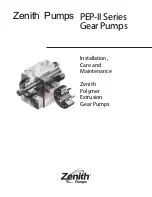
String Vibrator
Wave Speed
14
®
2.
Cut about 1 m of elastic cord. Measure its exact unstretched length. Measure the mass using a
balance. Calculate the Unstretched Linear Density (mass/length).
(If your balance is not precise enough to measure 1 meter of cord, measure the mass and
length of a much longer piece of cord, and use those measurements to calculate the linear
density.)
3.
Attach the cord to the blade of the String Vibrator. Tie a short loop in the other end and slip it
onto the hook on the Force Sensor.
4.
Plug in the AC power supply, and connect it to the String Vibrator.
5.
Move the force sensor or String Vibrator to adjust the tension in the cord so that it vibrates in
three or four segments. As you adjust the tension, check the end of the vibrating blade; there
should be a node at the point where the cord attaches to the blade. It is more important to have
a good node at the blade than to have the largest possible amplitude.
6.
Record the number of segments
Tension
You will use the force sensor to measure the tension of the cord.
1.
Set the sample rate to 100 Hz.
2.
Unhook the cord from the force sensor and zero (or tare) the sensor. Reattach the cord.
3.
Record data for a few seconds.
4.
Find the average force. This is the tension (F) of the cord.
Wave Speed Calculated from Wavelength and Frequency
1.
Measure the stretched length of the cord (L) from the force sensor hook to the String Vibrator
blade. Use this measurement and the number of wave segments to calculate the wavelength,
λ
. Hint: one wavelength is two segments.
2.
The speed of the wave (v) is related to the wavelength (
λ
) and the frequency (f) by
(eq. 1)
v =
λ
f
Calculate the speed of the wave.
(f = 60.0 Hz in the U.S., f = 50.0 Hz in most other countries.)
l
Содержание WA-9857
Страница 26: ......












































